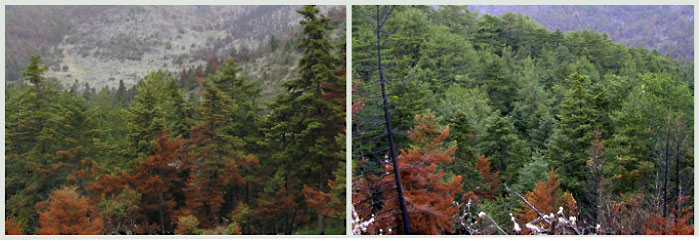Black pine forests

The black pine (Pinus nigra) is one of the typical species of the paramediterranean region and spreads naturally from South Spain to Greece, Cyprus and Turkey but also to N. Africa. It also occurs in Crimea, Ukraine. In Greece, its distribution extends from the northern border in the geographical area spread of the beech (Fagetalia) to the Peloponnese in the area of the paramediterranean vegetation (Quercetalia pubescentis). It also occurs on Lesvos and Samos islands.
It is a long-lived frugal species, resistant to drought, low temperatures and winds, able to adapt ecologically and physiologically to very different environmental conditions. It colonizes various ecological niches (as, for example, land abandoned by agriculture and livestock), plays a leading role in different stages within forest succession, in soil protection against erosion and torrential floods and acts as a carbon sink contributing to the absorption of the atmospheric CO2.
The species forms extensive forests, with individual trees reaching up to 20-40 m height, rarely to 50 m. The trunk of the black pine is straight and the shape of its crown is pyramid-like at the beginning and later umbrella-like. Every 2-3 years the species shows a maximum in the formation of cones and seeds which ripen during winter and fall to the ground by next spring. It doesn’t have closed cones or seeds on dormancy.
The forests of black pine form the priority habitat type “(Sub-) Mediterranean pine forests with endemic black pines" included in the Annex I of Directive 92/43/EEC (Habitats Directive). Prior to the wildfires of 2007, this habitat type displayed an excellent representation and good conservation status, on Mount Parnonas but also in Greece.
The black pine, when managed in a sustainable manner, produces valuable timber. The wood is of good quality and it is widely used in construction, shipbuilding, mining and industry. It can also be used in establishing artificial forests for aesthetic or protective purposes (on bare soils, poor in nutrients and moisture).
The main threats to the species include unsustainable cutting for production purposes (particularly timber), spread of invasive alien species, defoliation by insect pests (especially Thaumetopoea pityocampa), overgrazing, genetic pollution and fires. The black pine is adapted to low-intensity understory fires but not to large crown fires, which increasingly appear in recent years, destroying large areas of forests. Crown fires destroy the black pine’s cones and seeds that have not reached ripeness, so the forest can not regenerate naturally. Natural regeneration occurs in cases where islets or individual trees are maintained which could gradually act as seed providers, a process that takes time.

